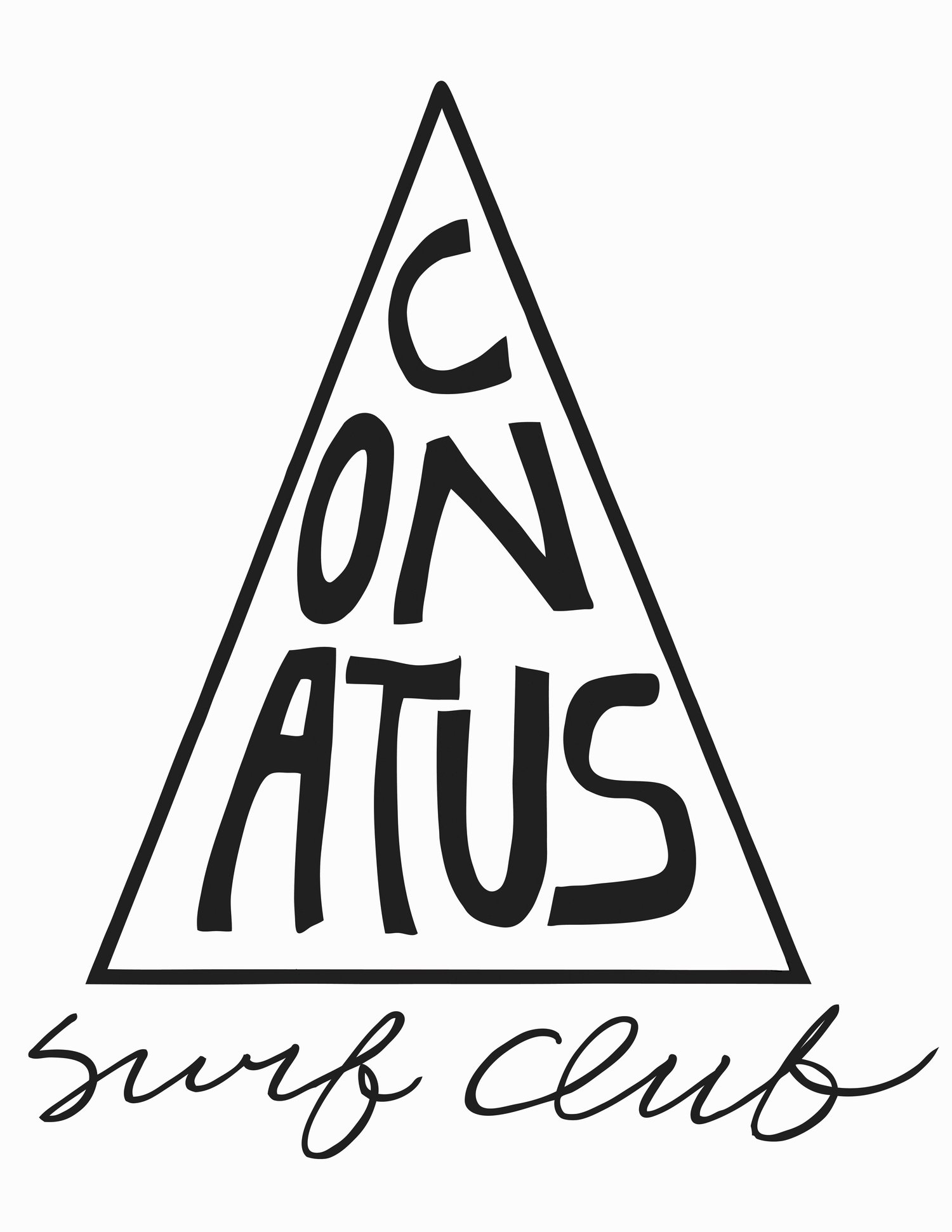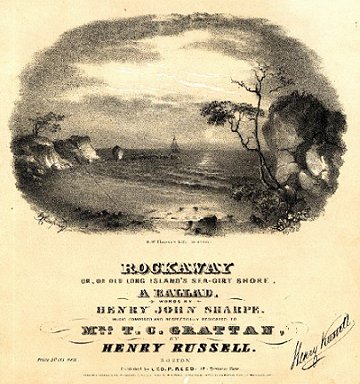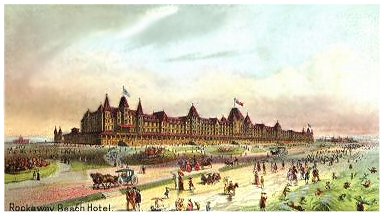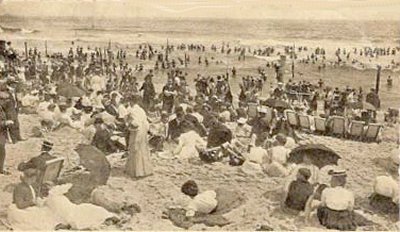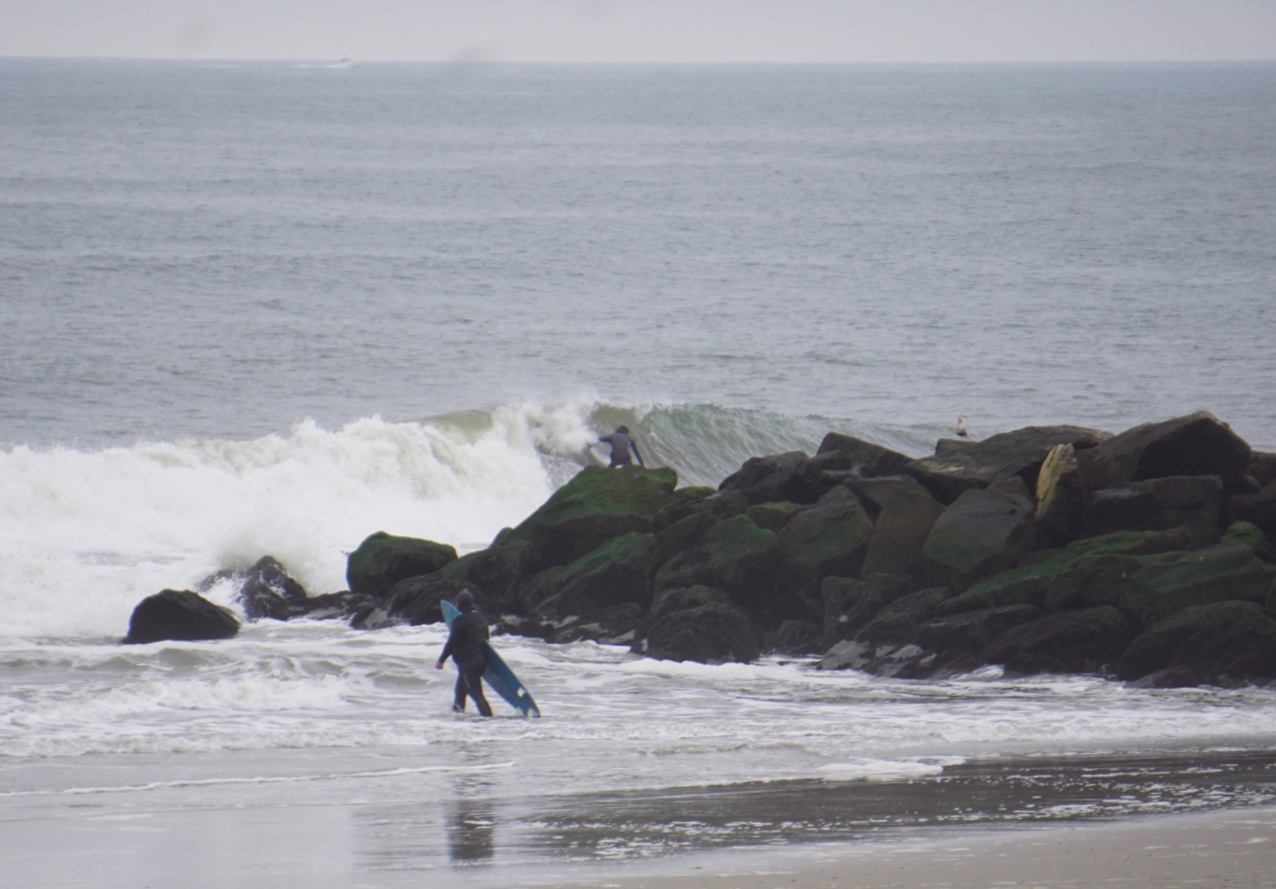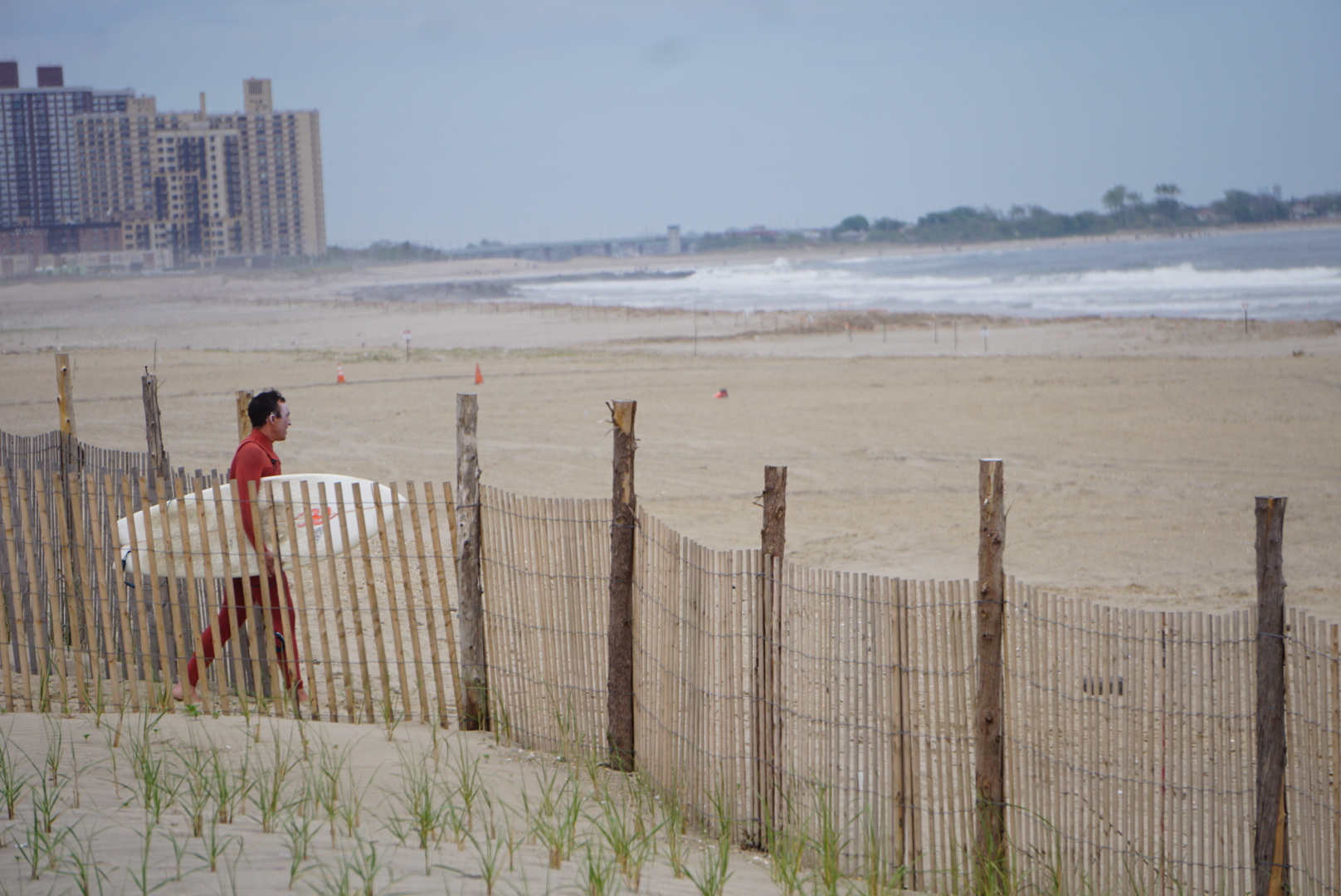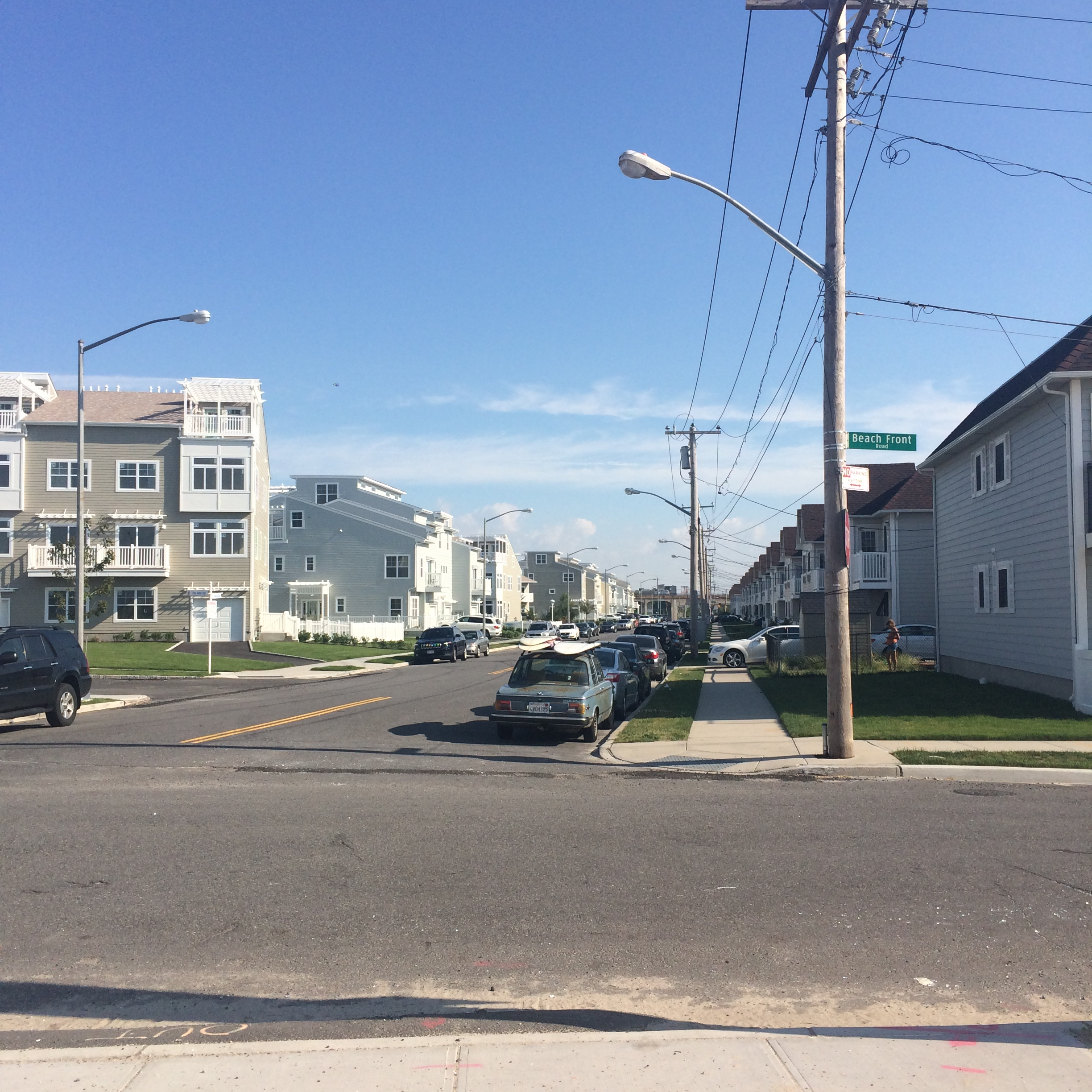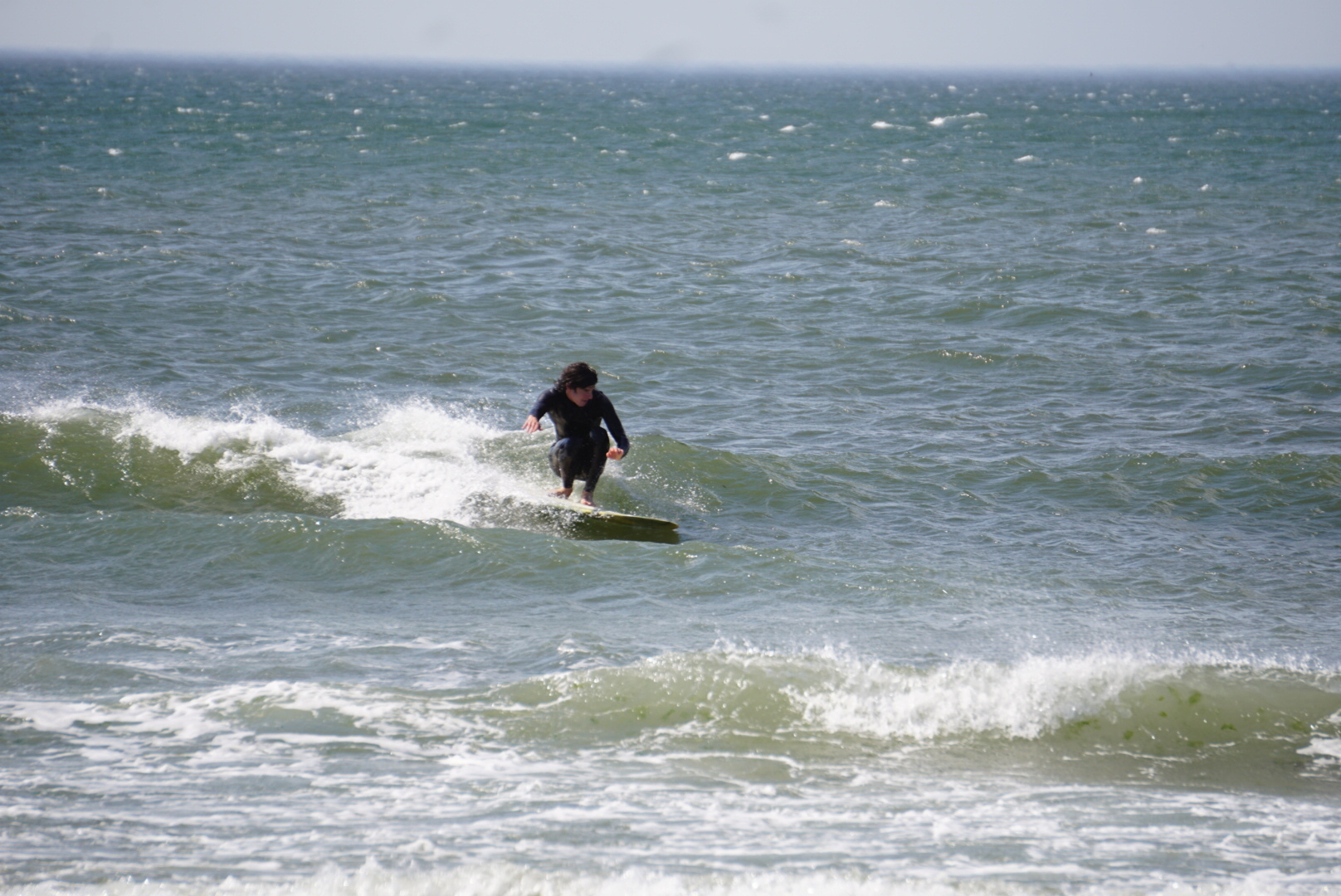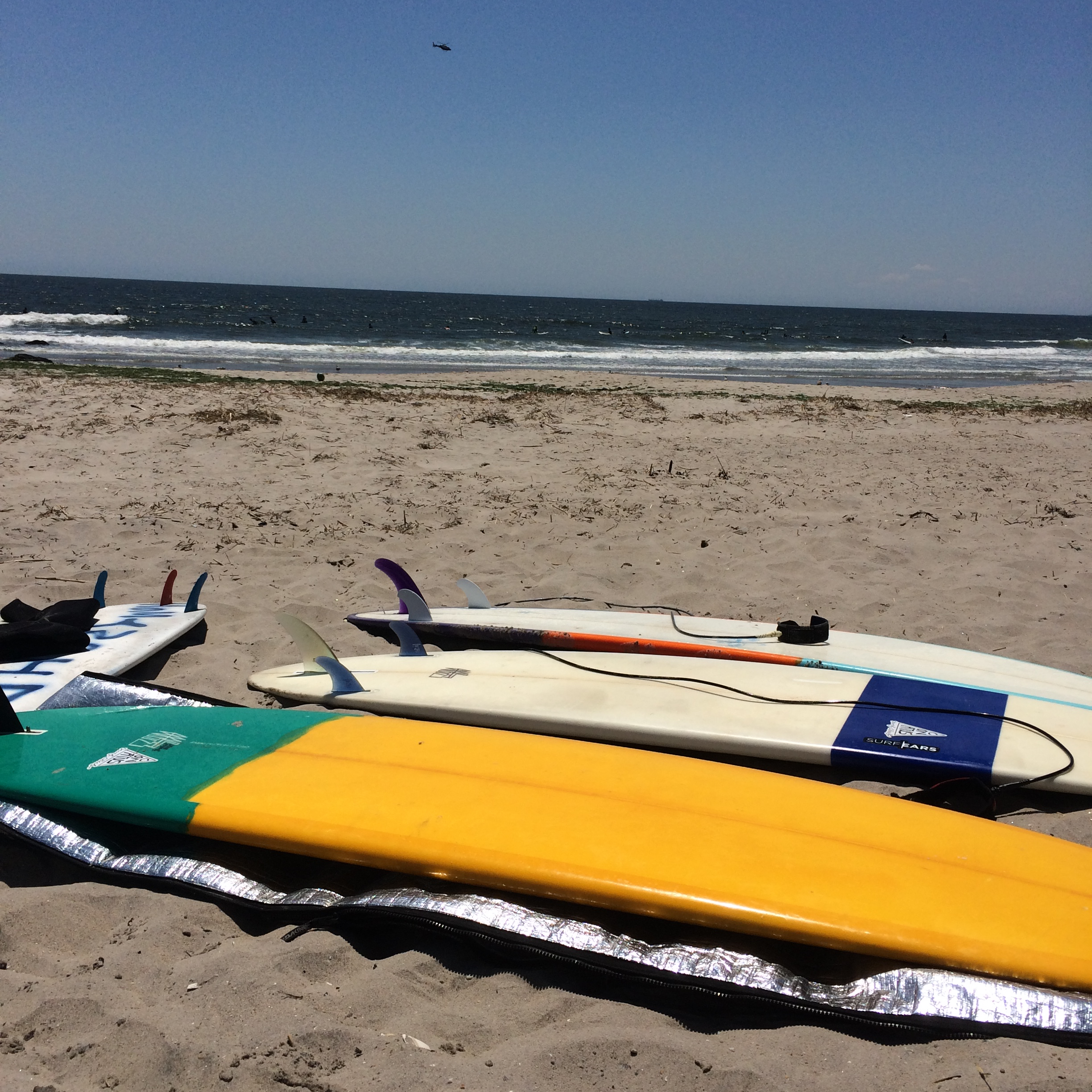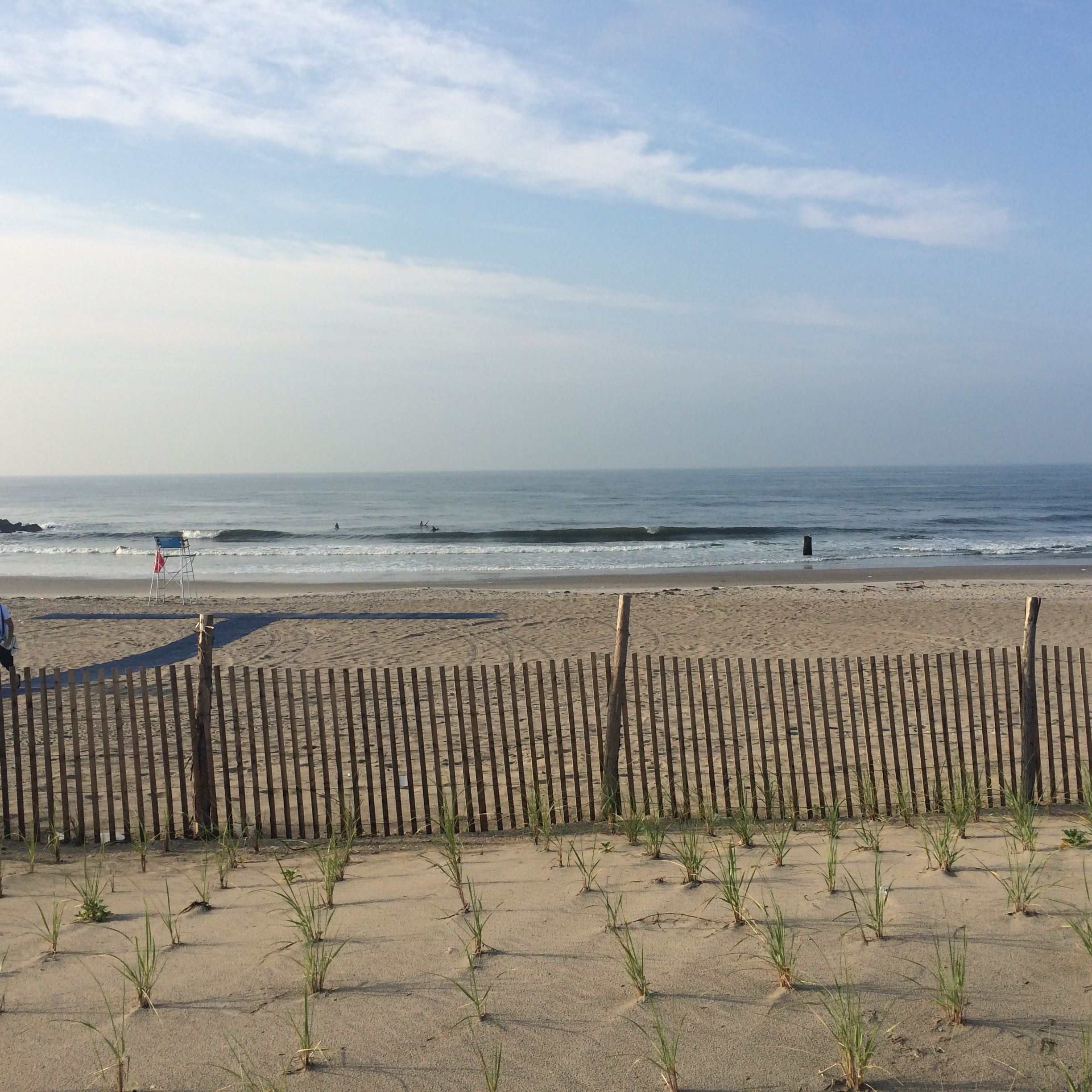Here's the video of the first full day of our third retreat. The previous one was a half day with Andrew and I surfing first. This one includes all three students: Christina, Johan, and Mariza who successfully dodged volcanoes to join us just one day late. The waves were on point once again: 2-3 feet and offshore in the morning, and glassy in the afternoon; lefts and rights. Everyone made huge progress with dropping in at the power source. We also had an epic fish and vegetable feast. Stay tuned for Day 3!
CSC x RDA Retreat 3 Well On Its Way
I thought I would do something different for this year's Costa Rica retreats and post our daily videos to the blog so that you all can follow the great times and waves that we're having down here. Above is the video from the first day of trip. Andrew and I "test out" the beach break to make sure that it is acceptable for the students. It was. Then we drove to Quepos to pick up Johann and Christina, both of whose flights successfully landed despite warnings that the Turrialba Volcano near San Jose Airport was going to spew a bit of ash into the sky. Our third member of the full retreat (we're getting a halfway member in a few days), Mariza, was not as lucky and had to spend the night in Miami awaiting a non-cancelled flight on American Airlines. [Word to the wise: lots of other carriers are landing in San Jose, but American seems to be a lot more conservative and cancels more flights.] You will see her in the next video as she arrived yesterday. After we settled Johann and Christina into their rooms, we got in a sunset surf at Playa Chaman. We finished the day with dinner of warm cabbage salad with roasted broccoli, shredded carrots, and bell pepper, tossed with a citrus vinaigrette and seared chicken breast stuffed with pesto. Dinner was followed by raw video screening and a seminar on how to use the lower body for turning.
Our goals for this crew this trip are: learn the fundamentals of turning, more board control on the inside, walking up and down the board (weight distribution generally), continued work on paddling form, graceful kickouts, backside butt drags, and hopefully a head dip or two. Everyone has had lessons with us in NY and already has the early fundamentals down, so now it is a matter of helping them engage their fins and rails to experience new parts of the wave. Another huge theme is to find the power source both for take off and for riding the wave, i.e., to make strides on wave judgment skills.
It's 5a right now. Andrew is making smoothies and we can hear surf pounding down the mountain. I still have to edit yesterday's video, so the posts are going to be 1-3 days after the day the video was created. Stay tuned!
Winter Wetsuit Primer
Sea Lovers!
Despite popular lore, we are now firmly ensconced at the beginning of the true surf season on the East Coast —September-March. Popular lore holds that the surf season equates to "the season", i.e., the summer season, but any true surfer will tell you that the waves do not really pump until hurricane season begins. Once hurricane season ends, winter (hopefully) brings northeast swells pulsing down our coast. This brings me straight to the point of this post: you need to be prepared gear-wise if you are going to surf through surf season proper.
A drainer from last February. Don't let lack of solid gear keep you away from great winter surf. Pic: Dion Mattison
Right now the water remains in the mid to high 60s but air temperatures are dropping and windchill is increasing with blustery gusts from the NE and NW respectively. This makes the ocean feel like a bath while the air whips itself through your suit and into your bones. It also makes choosing the right suit a dicey proposition. Do you just wear your 3/2 fullsuit? Or do you add a hood and booties? If the water is still in the 60s can you get away with a spring suit? First of all, everyone has her or his own different comfort levels. A good rule of thumb for all things in life is to know thyself. I, for example, know that I can get away with less rubber if I plan to have a short session (under one hour), but if I plan to surf all day, then I need to wear a thicker suit and have a dry one or two on the back burner for the second or third sessions.
A bevy of 3/2s drying in the Rhode Island sun, ready for multiple surfs #moresuitsmorejoy Pic: Dion Mattison
If you have ever chatted to me about surfing gear then you know that I espouse maximalism — especially for the wide ranging temperatures on the East Coast. On the coldest day in the middle of February the water can get as low as 35 degrees; whereas the warmest day in August can see water temps in the mid 70s. When you add this to the fact that in order to get better at surfing (at whichever level you are at), you need to surf at least 2x a week (bare minimum), it equals owning a lot of neoprene products ranging from 2mm springsuits and jackets to hooded 5/4 fullsuits and 7mm mittens. In order to take your practice through the entire surfing season here is my bare minimum gear recommendation:
- One 3/2mm fullsuit
- One 4/3mm hooded fullsuit
- One hooded polypropylene shirt or vest
- One pair 3mm or 5mm round or split toe booties
- One pair 7mm roundtoe booties
- One pair 3mm or 5mm five finger gloves
- One pair 7mm mittens (no fingers/not even lobster claws)
Allow me to explain these seven choices: The 3/2mm is for right now through the end of November and even through parts of December, water and air temps permitting. Top of the line 3/2s these days are as warm as the 4/3s of yore and a zillion times more flexible. Plus you can augment/bolster your 3/2 with your lighter set of boots, gloves, and/or your hooded polypropylene shirt or vest. For colder, windier days from now till the end of winter you'll want to don the hooded 4/3 with varying thicknesses of gloves and boots per the air and water temps. For example, last Saturday I wore my hooded 4/3 Oneill Mutant (the Mutant is a suit with a detachable hood — kind of neat) sans gloves and boots. I will often stay away from neoprene on my extremities until absolutely imperative. I hate booties because I like to feel my feet in the wax, and I hate gloves even more, but both become necessary as water and air temps dip below 50 degrees. One word on why I say a hooded 4/3 vs. a hooded 5/4 (if you have to choose): flexibility. The 5/4s can make you feel like a sausage in a casing and can really inhibit your movement. Plus you can ramp up the warmth of your hooded 4/3 in the deepest trenches of winter with the 7mm gloves and boots. When the water and air get into that dreaded 40s and below range the extremities need maximum protection while the core needs to be able to move. I recommend mittens instead of five fingers or lobster claws because your digits are better off next to one another than apart. If you have to cover your hands then it's really freakin cold, and you'll want to protect those babies to the best of your ability. I want to stress that the above neoprene quiver is the bare minimum. Here is a more maximalist suggestion:
- Two 3/2s
- One hooded 4/3
- One hooded polypropylene shirt or vest
- One crew neck polypropylene shirt
- One hooded 5/4
- One pair 3mm split toe boots
- One pair 5mm split or round toe boots
- One pair 7mm round toe boots
- One pair 1.5mm five finger gloves
- One pair 3mm five finger gloves
- One pair 5mm lobster claw gloves
- One pair 7mm mittens
This quiver will allow you to be prepared for whatever weird variations the weather throws at you. Plus you'll be able to always put on dry gear, which becomes an utmost necessity in the coldest months (Jan-March). Of course only the most diehard will go this far. Others may opt for the former suggestion coupled with plenty of trips to warmer reaches.
Me, Dion Mattison, on a Rockaway screamer last February in a hooded 5/4, 7mm gloves and boots. Pic: JP Phillips
In terms of quality and price I must advise you NOT TO SKIMP on winter gear. This is serious. If you try to get the cheaper stuff you will freeze and it will make surfing very un-fun. Some brands, like Patagonia, Matuse, and Nine Plus, do not even make middle of the road products because they do not want you to go through that kind of pain, i.e., they have integrity. The more mainstream brands like Ripcurl, Oneill, Xcel, Billabong, and Quiksilver are all making competitive top of the line stuff but their cheaper price tag gear is absolutely atrocious and is only, if ever, to be worn in the summer months (mostly for sun and wind protection). There is also Need Essentials, the new brand I mentioned in the summer suit write up. These guys have a hooded 5/4 at about $235. I have not tested it yet. I am happy with the 3/2 I bought from them for $125. Their philosophy is to take all of the packaging, logos, and marketing out of the wetsuit design process in order to make a quality suit at a fraction of the cost. Ultimately your choice of brand is going to come down to what you view to be the most ethically sound choice based on your consideration of environmental, economic, and aesthetic conundrums. We do, however, recommend supporting local shops like Maritime Surf, Pilgrim Surf + Supply, and Saturdays' Soho and West Village locations — links to all shops are in sidebar.
CSC stalwarts Beccy and Paul out for a winter lesson last year. Having the right kit is one of the keys to rapid progress. Pic: Dion Mattison
Last note: the cardinal rule of surfing more than one time a day in the winter, as mentioned, is to always put on a dry wetsuit. I must add to this that if you have a choice between two dry suits and one is thicker than the other, always wear the thickest suit for your first session! You're fresher in your first surf and can handle the extra friction of the thicker suit. You'll stay warmer longer and not freeze yourself to the bone. Your second session will necessarily be later in the day when it is slightly warmer out; plus you will be tired from the first session and so the thinner suit will help with flexibility.
I hope this post helps everyone get the most out of our east coast surf season. Winter surfing is not for the faint of heart, but staying on it through the cold months will transform your belief in what is possible.
Conatus x Hermine
Aquanauts!
What an incredible run of surf we have been having on the eastern seaboard! I hope that everyone reading this has had his or her share of waves with a only a modicum of overfroth, lineup etiquette disputes, and/or surf-induced injuries. We at Conatus have had several successful surf sessions during both the Hermine and Karl swells. At this point it would be hard to compare the two for epicness, as both were completely different kinds of swells that offered us amazing experiences with a variety of crew. But this post is about Hermine because, first, she came before Karl. Second, she's a lady. And third, there is a sense in which the excursion that went down for Karl was more momentous for us as a business, and for that reason we're saving it for our next newsletter (better sign up).
Dion in a fun little tube on Hermine Day 3. Photo: La Vida Escondida
The week before Labor Day weekend we all saw our respective surf forecast sites of choice (ours is Swell Info) light up with colors symbolic of firing surf (green, yellow, orange). We saw wave heights ranging from 4-10ft, and for Andrew and I it was a no-brainer to cancel lessons for the weekend. We do have a crew who are ready to start charging larger surf, but we wanted to wait and see what the swell really looked like before making any calls on whether to take students out or not. We did do lessons the Saturday prior to the swell hitting and it was almost entirely flat with dismal weather, but there were a few promising Hermine pulses now and then before the wind came hard onshore out of the ENE.
Sunday morning Andrew and I woke up frothing. Buoys were way up and the winds were light offshore. One of our stalwart students, Paul Saliba, came to the beach with us just to check it out and film a little. We checked Rockaway first and it was completely on fire. Easy 4-6ft with a few 8ft sets and spitting barrels with no one out (where we were looking). But after watching a few sets roll in we saw a number of wonky close outs and decided that Long Beach might be handling the huge high tide a bit better. Long Beach was smaller, still in the 4-6ft range, but not as walled up as Rockaway and definitely far fewer closeouts. Upon full analysis, we actually felt that we should have surfed Rockaway, but we did not want to waste any more time checking and suited up in Long Beach. Our reasoning was that we had already broken the golden rule of surfing — never leave waves — once, and we did not want to make the same mistake twice. Long Beach was certainly fun. After weeks of knee to waist high surf (which is still fun, not gonna lie) it felt great to be in waves with some juice.
Long Beach on the first day of the Hermine swell. Pic: Dion Mattison
Dion going down the line on an inside runner at Grand Ave. in Long Beach on Hermine Day 1. Pic: Paul Saliba
After our first session we got a call from our compadre Johnny Knapp who was down surfing a different jetty, and went down there to have a surf with him. The swell was pulsing harder now but the winds were coming up harder and harder out of the NE making the waves incredibly shifty and strengthening the current. I had a hunch that this might be a perfect time to try our hand at some breaks in Rhode Island that are more sheltered from that wind. I paddled up to Andrew and said, "Let's get in the van and go surf RI." Being born of the same banching* blood as me, Andrew was down without hesitation. We dropped Paul off at the train, skirted up 95, and were in Rhode Island by 3:30p. It was a pinch smaller than NY but absolutely on fire.
Andrew surveys a pumping RI lineup, Hermine Day 1. Pic: Dion Mattison
We surfed until dark and then met up with our good friend Tyler Garceau. Tyler was born and raised in RI and has a beautiful piece of property in striking distance from a variety of great surf spots. We texted him on the way up and he was exceptionally down to let us camp overnight. We grilled steaks and sautéed spinach and washed it down with a few beers around a raging campfire.
Nothing to end a great day of surf like a bonfire.
We were up early and back at the beach. The winds were still howling out of the NE, making it only possible to surf south facing spots. This in fact was a peculiarity of the Hermine swell (and of a lot of the systems that we're receiving this fall). Waves were much bigger on Day 2 in RI. We surfed a spot the locals call "Trestles", a reeling left and right over cobblestones. The session was incredible fun with long peeling walls with room for a number of turns. After that surf, however, we had a feeling that it was probably a good idea to head back to NY to see about some tubes.
Dion exiting the water at "Trestles", Hermine Day 2.
We were back on 95 in the van in no time. It was a smooth drive with no traffic and we arrived in Long Beach in the mid afternoon to a whole crew of friends and overhead pumping tubes. As fun as RI was, and it was really fun, Long Beach was clearly the place to be for this swell.
Long Beach, Hermine Day 2.
We surfed our brains out until dark with our good buddies Juan Heredia and Johnny Knapp. Juan was picking off these incredible bombs just on the other side of the jetty. Andrew and I were switching off boards and cameras, and Johnny was going to town on his two near 6' Joe Falcone shapes with smooth wrapping cutbacks and off the lips. We had beers on the beach to celebrate followed by pizza at Gino's of Long Beach, and then all camped out in our little Long Beach surf hovel to be prepared for a third day of action.
Johnny Knapp in the pocket with duckdiver and seagull, Hermine Day 3.
We had debated going to Rockaway in the morning of Hermine Day 3 (aka day after Labor Day) to find some more top to bottom barrels, but opted to check Long Beach first. My worry was that Long Beach was going to look too firing for us to leave and that we wouldn't even go to check Rockaway due to the cardinal rule of surfing (again, never leave waves). When we pulled up to LB it was 3-5ft with A-frames everywhere, and that was it. As suspected, we threw our suits on and hustled out there. Earlier in the morning, realizing the swell had come down a bit I had called some of the Conatus student crew who I knew were ready to get into some juice — Scott and Jo Becker, Mariza Daras, and Christina Nizar. They showed up after my first session while I was filming Johnny, Juan, and Andrew trade almond shaped spinners. Jo and Scott paddled out first and Mariza and Christina were close on their heels. It was cool to see them all out pushing their levels on what I think would probably count as their first hurricane swell.
Christina Nizar and Mariza Daras preparing to charge, Hermine Day 3.
We surfed all morning and then by midday the wind got stronger and the swell really started to dissipate. The Becker crew, with their good buds Chito and Suzy from Costa Rica/UK in tow, were headed back to Montauk where they had been renting a house for the week. The original plan, in fact, was to surf Montauk more this swell, but the winds decided it would be otherwise. It just doesn't like 20-30 knot NE wind up there. But the forecast for the last few days of leftover Hermine swell was looking good up there so we hopped in the van and headed east. We didn't surf that evening, but we heard that Long Beach was still good. Johnny and Juan surfed a beach just east of where we had been at all swell and they said it was much bigger.
We got to Montauk in record time — apparently no one wants to drive out there on a stormy Tuesday — and spent the evening playing dice games with Jo, Chito, and Suzy. Then we woke up on Hermine Day 4 and started surf checking all over again. It had some wonk to it, but there was still size and a lot of promise of cleaning up. Paul Saliba (remember him from Day 1?) took the train out and we all headed to Ditch for a fun little slop session. The locals were tearing it up and Paul and I headed out the back for his first deep water surf experience.
Andrew, Jo, Paul, and Chito check out a high flying local in Montauk, Hermine Day 4.
That session turned out to be a blast and a good experience for Paul. There was a lot of water moving and it required a lot of paddling to stay in position. I posted up in the afternoon managing our social media feed while Paul and Andrew went fluke fishing. They nailed 4 fish in the space of 45 minutes. With dinner settled, we drove back to the beach for a little evening session. This time we opted for the beach break near town. It was sloppy and chunky but a few gems were rolling through. Paul, ever keen to master all aspects of being a good crew member, stayed on shore and shot some snaps of Andrew and I.
Andrew going straight up on the 5'6" Falcone keel fish, Hermine Day 4. Pic: Paul Saliba.
Surfed out beyond belief, at night we gorged on fresh fluke cooked both whole and made into ceviche by Andrew. We conked out early and woke up to a stunner of a Montauk day. Paul and I surfed Ditch. For the first time in days I rode a longboard. It was gentle and crowded. We knew the beachies were absolutely firing, but it was time to get back in the swing of assisting others in their surfing practice. After that session we went for another fish, this time off Gosman's Dock at the entrance to the Montauk harbor. Despite a keen lack of desire to jig the rod, I actually caught and landed a pretty good sized one. After Andrew caught three more, we loaded up the van, and headed back to Brooklyn.
That night we read every possible story about the Hermine swell on Instagram, Surfline, and the Inertia. It looked as though everyone scored. People got ticketed for surfing Rockaway. That was a real bummer to hear, but it made me kind of glad we didn't surf there the first day. De Blasio is good at a lot of things, but he's certainly way behind the curve when it comes to understanding surfing and surf culture. The NJ and NY shortboard pros absolutely gorged on tubes at Lido. Seeing their footage made me feel little bad we didn't check out and surf that zone. And our good buddy Sam Shainberg stayed in RI longer than us surfing pumping point break waves. I questioned whether our choice to drive so much paid off and thought about the myriad other ways we could have done better. But when I look back at the footage and think of all the great times we shared with a variety of people, I cannot help but feel grateful. Next time, on a similar kind of swell, we will certainly try to get bigger and better tubes, and we will also call more students out to push their levels. And in this regard, Hermine was truly exceptional: she enabled us to learn something about swells of that size and direction, where and how they can be expected to break and in what kinds of ways; she put us in touch with a variety of excellent people; and she ultimately taught us more about ourselves.
Suzy surfed out!
Beach Lunch
Beach Lunch
If you've been out with us, you may have gotten to partake of one of Andrew's famous van-side beef stews or fried egg breakfasts. But you don't need a camp stove and full kit to enjoy a wholesome lunch. Not only are we saving tons of money by bringing our own food (even a bagel and coffee can run you around $5), but we're looking after our nutrition and feeling awesome. Anybody who's spent much time out there knows that beachside food options can be challenging. Not that we don't love the occasional stuffed veggie slice from Gino's at Long Beach, but we thought we'd share some of our favorite ways to eat healthy on a mission.
No refrigeration needed
When we're in a hurry, we like to bring along sturdy, pre-washed fruits and vegetables. Think bell peppers (you can even eat one like an apple–try it), carrot and celery sticks, jicama, bananas, apples, tangerines. We keep a pocketknife and flexible cutting board in the van, but it's not necessary. Slice them up the night before and toss them in a Ziplock bag or Tupperware. If you want to up your game, you can bring a whole avocado, slice it in half, and eat it with a spoon right out of the shell. Pair that with a few hard boiled eggs* and you've got a protein and vitamin boost to get you primed for the next session. As a side note, we find that hard boiled eggs are just fine out of the fridge for a while. Put a pan of them on the night before, and bang—breakfast or lunch, already in its own container. Other protein sources that will be okay in your beach bag for a few hours include nuts (we love smoked almonds) and cured meats (think hard, really preserved stuff like chorizo, smoked salami, or jerky).
A little more fancy
If you have a decent cooler or insulated lunch bag, the sky's pretty much the limit. We like to take chicken or tuna salad and have that with crackers or vegetable sticks instead of in sandwiches. You can bring cheese cubes, yogurt, hummus, leftover dinner from yesterday. We've discovered the awesome Bentgo salad box, which means you can bring a restaurant-quality salad in your backpack. It has a bottom container for greens, and the top tray has compartments for your toppings, and even its own fork and a leak-proof box for dressing. No more soggy lettuce!
While we're plugging lunchboxes
Bentgo makes a ton of awesome products. In addition to the salad box, we use the Bentgo insulated canvas lunch box almost every day. It's the perfect size for one person, and it has a built-in pocket for an ice pack. You can buy a super slim cold pack from them that fits right in.
If you're packing for a crowd, Andrew swears by the soft cooler. You shed a lot of the weight of a hard box, making it a cinch for one person to tote around. They also usually have a few outside pockets so you can reach for a few snacks on the train. The squishy sides mean that it's easier to fit into small spaces (Brooklyn apartments, anyone?) and you can fold it up and shove it in a drawer when you're not using it. They're also super easy to clean by rinsing out in the sink. Some people like to dump a bag of ice right in these, but we usually rely on reusable cold packs that we store in the freezer till we need them. Less risk of a soggy PB&J. In coolers as with everything else, you get what you pay for. A cheap soft-side from the dollar store won't last long. We suggest you shell out a little more and invest in a mid-range cooler that will last several seasons and keep your stuff colder longer.
Hope this gives you a few suggestions to spruce up your beach snack routine. It doesn't have to be a big production—a few minutes the night before really pay off when you're enjoying a gourmet feast right on the sand. We're really into our home cooking routine these days, so look out for more posts about our favorite beach breakfasts, new recipes, and more.
As a final public service announcement, please, please, please remember to pack out what you pack in. Our city beaches seem to get more polluted each day. Take those wrappers and rinds back to a trash bin, or haul them back home to dispose of properly.
*Fool-Proof Hard Boiled Eggs
These beauties come out perfect every time. We can't recommend enough that you spend a little more for organic, free-range eggs, local if possible. The taste difference alone is worth it. Make extra—everybody loves deviled eggs.
1. Fill a four- or six-quart saucepan with water. Place over a high flame and bring to a boil.
2. When the water is boiling, gently lower the eggs into the pan. Adjust the flame if needed to keep the water at a steady boil (you might need to turn it down slightly).
3. Boil for 11-13 minutes. This is a matter of taste. If you like a softer, creamier yolk, less time is for you. If you're taking them to the beach, we'd suggest the longer time. They'll keep longer if they're fully cooked through.
4. Turn off the heat and use a slotted spoon to remove the eggs. Immediately place them in a bowl of ice water. Let sit for 30 minutes. Don't skip this step!! Plunging the eggs in the ice bath makes them much easier to peel.
Mid Summer Melville
Sea Lovers!
What a stellar summer so far! We just passed the mid mark and recently experienced perhaps one of the weirdest weeks of weather in a while. It was the first time all summer that we had a few days that were simply too flat and onshore to surf. But because the ocean doesn't like to do the same thing for too long, we were welcomed with a bunch of fun waves the past few days. Andrew and I have paid witness to many fantastic breakthroughs in the past week, and we want to give a shout out to those of you who recently took your surfing to a new level, you know who you are!
We have a bunch of fun stuff on the horizon: Many people have signed up for the Newsletter and we're currently working on the first one. Should be out some time next week. We've got the retreat dates up for Costa Rica Winter 2016/17. Go have a look and try to book early as we imagine that after last year's awesomeness these will fill up fast. As for our local business, we are starting to be pretty booked for August (especially weekends) but still have a few openings (especially weekdays). Since purchasing our van, our mobile operation has really taken off this year, and we have had tons of full beach days all around the NY/NJ area. We are starting to firm up some short trips to Montauk, Rhode Island, and Cape Cod for the fall, so stay tuned for those!
I will also admit right now that is is my second attempt to write this blog post. In my first attempt I was desperately trying to interpret this fantastic Melville quotation from Moby Dick:
“Go visit the prairies in June, when for scores on scores of miles you wade knee-deep among Tiger-lilies—what is the one charm wanting?—Water—there is not a drop of water there! Were Niagra but a cataract of sand, would you travel your thousand miles to see it? Why did the poor poet of Tennessee, upon suddenly receiving two handfuls of silver, deliberate whether to buy him a coat, which he sadly needed, or invest his money in a pedestrian trip to Rockaway Beach? Why is almost every robust healthy boy with a robust healthy soul in him, at some time or other crazy to go to sea? Why upon your first voyage as a passenger, did you yourself feel such a mystical vibration, when first told that you and your ship were now out of sight of land? Why did the old Persians hold the sea holy? Why did the Greeks give it a separate deity, and make him the own brother of Jove? Surely all this is not without meaning. And still deeper the meaning of that story of Narcissus, who because he could not grasp the tormenting, mild image he saw in the fountain, plunged into it and was drowned. But that same image, we ourselves see in all rivers and oceans. It is the image of the ungraspable phantom of life; and this is the key to it all.
”
What happened was that like everything in Moby Dick, there was simply too much to say about it and I got stuck. Here Melville nails a description of our magnetic attraction to the sea — the ocean and the water that comprises it beckons us both consciously and unconsciously. It is the simultaneous source of great fear and great bliss — "the image of the ungraspable phantom of life." As the religious historian Mircea Eliade once said, the sea is the fons et origo (fountain and origin) of all being. Those of us who have dedicated our lives to it know this to be the case in a visceral way. This is also what is so astute about connecting this aboriginal attraction to water with the myth of Narcissus: a deep part about what attracts Narcissus to himself in the water is the fact that he is made of that same water in way that is not just a mere hallucination or trick of light. What Narcissus also teaches, however, is that if you do not respect the power of the water over you, you risk dying from your own ignorance. Narcissus forgets too quickly that the same self love that preserves him can also destroy him. It is always crucial to remember that we are all bound together in this watery world.
The other thing that really strikes me from this passage is the mention of Rockaway Beach. It is of interest to learn that literary scholars are at a loss as to the 'true identity' of the "poet from Tennessee" who forewent a coat in lieu of a trip to Rockaway Beach. The best answer anyone has come up with is that it is one of Melville's weird inside jokes or innuendos. Beyond this it just makes me wonder what Rockaway Beach must have looked like in the 19th century. Surely there weren't any jetties or piers. A brief internet search yields some telling photos. By the mid 19th century Rockaway was already a bustling hub of beach activity. Old post cards show that just as many people visited there then as they do today. But of course the area itself looked nothing like it does now. There was once a big hotel called the Rockaway Beach Hotel and lots of open land and dunes. Now is not the time for me to write the history of Rockaway Beach, but I have a huge hunch that Robert Moses has a lot to do with why it looks how it looks now (I still need to read The Power Broker by Robert Caro). From the images alone it looks as though it was as popular in 1851 as it is in 2016. The waves and sandbars had to be different without the jetties, but I also imagine that for an unmeasurable amount of time there were plenty of epic A-frame beach break set ups going unridden from one swell to the next.
There is a lot more I can say about contemporary Rockaway: they did end up taking away 61st and 62nd streets as surfing beaches. It would almost be a bummer but this summer it has been so polluted with weird nitrogen growth kelp and plastic bags and leftover weekend trash that we have tried to surf there only when absolutely necessary. The politics of surfing beaches and lifeguards and waste management is so deeply entwined and entangled in daily politics that I am wary of touching it with a ten foot pole. But it is certainly there in the back of my mind always wanting to be mulled over and grappled with more actively. I still think that if you live in New York and you have not visited the Rockaways you are missing out — it's wild to see that there is really such a vibrant beach scene so close to the mother of all modern American cities.
And don't get me wrong, despite the plastic bags, crowds, and closed beaches, there is still great surf at the famous Rockaway Beach. I always say that it is one of the best places to find a barrel on all of Long Island. The short distance between the jetties focuses the swell (when there is some), and the shallow sand causes the wave to jack up and throw out rapidly. In terms of scenery, the new boardwalk is a welcome addition to the landscape of high rise condos, churches, and other urban markers. And you can always see Long Island, Manhattan, and New Jersey off in the distance as the huge box ships make their way into the harbor.
Furthermore, in just one month all of the rules and regulations placed upon surfers to avoid swimming areas in Rockaway, Long Beach, and New Jersey will be null and void. Any die hard surf fan of the NY/NJ area will tell you that Labor Day is the official start to our real surf season, and we here at CSC are psyched for it!
-Dion
